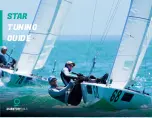
Operation
98
Post-operation checks
These post-operation procedures are devel-
oped to help preserve the long-term appear-
ance and reliability of your boat. Perform
these procedures as soon as possible after
the boat is loaded back on the trailer after the
day’s use.
Some owners prefer to moor their boat sea-
sonally, rather than keeping it on the trailer
between uses.
Extended mooring is not
recommended.
Proper flushing of the cool-
ing system is not possible with the boat in the
water. In addition, conditions such as stray
electrical voltage in the water, marine organ-
isms, and saltwater corrosion can adversely
affect the life of many boat components.
NOTICE:
Leaving the boat in the water for
extended periods will accelerate the rate
of normal deterioration of the jet pump
components, sacrificial anodes, hull finish
and other components.
If you do decide to moor your boat, be sure to
remove it from the water periodically to clean
the hull and jet pump area. The frequency of
maintenance required will depend upon
whether the water is salt water or fresh water
and other local water conditions.
(1) After putting the boat on the trailer, flush
the cooling system to prevent the cooling
system from clogging up with salt, sand,
or dirt. (See page 104 for the cooling sys-
tem flushing procedure.)
(2) Drain residual water from the exhaust
system by starting the engine, and then
alternately pushing the remote control le-
ver up to half throttle and back to idle for
10 to 15 seconds.
NOTICE:
Do not run
the engine over 4000 r/min on land. Al-
so, do not run the engine for more
than 15 seconds without supplying
water, otherwise, the engine could
overheat and/or seize.
(3) Stop the engine.
(4) Wash down the hull, helm, and jet drive
unit with fresh water.
(5) Open the rear platform hatch. (See page
59 for rear platform hatch opening and
closing procedures.)
(6) Remove the access port cap to let any
water drain that has pooled on it. (See
page 120 for access port cap removal
and installation procedures.) If the boat
will be stored on the trailer nearby, leave
the cap out until you prepare to launch
the boat again. If the boat will be trans-
ported on the trailer any distance, tempo-
rarily reinstall the cap and close the hatch
until you get home. Open the hatch again
when you arrive and remove the cap as
before. Leave the cap loose until you plan
to transport the boat on the trailer again.
NOTICE:
Leaving the access port cap
out when you are not using or trans-
porting the boat helps keep it from be-
coming stuck in the access port.
(7) Remove the hull drain plugs and the fuel
tank compartment drain plug. (See page
77.)
(8) Rinse the engine compartment with a
small amount of fresh water. Be careful
not to get water on the air filter area or
electrical components. Allow any water in
the bilge to drain out. After the water has
drained, wipe the engine compartment
and bilge with dry rags.
(9) Reinstall all drain plugs.
NOTICE:
Tight-
en the hull drain plugs securely before
launching the boat. Otherwise, water
may flood the boat and cause it to sub-
merge. Clean any foreign material,
such as dirt or sand, from the threads
SportsBoat_F3M11.book Page 98 Wednesday, June 1, 2016 3:42 PM
















































